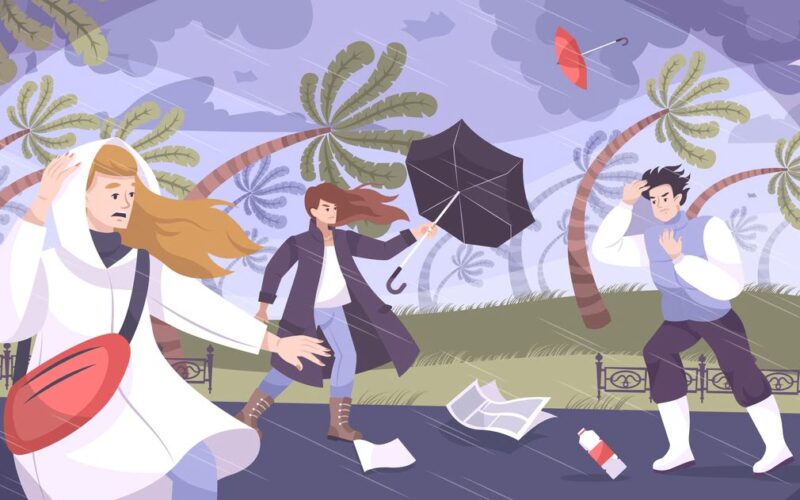What is the structure of a hurricane?
Storms are given different names based on where they occur. Hurricanes are tropical cyclones that form off the coast of North America, whereas typhoons form in the West Pacific. Cyclones are tropical cyclones that form in the Indian and southern Pacific oceans. Cyclones are distinguished by their clockwise rotation because they form in the southern direction of the equator (Dempsey, 2022). The center of the hurricane is the eye. The area where the eye of a hurricane is located provides mild weather because there are no clouds and no wind. This part of the snow is surrounded by an eye-wall, and the area located here can be damaged by strong winds. The outer side of the storm is formed by rain bands, which also cause a lot of damage due to strong winds and heavy rain (Means, 2017).
How are hurricanes created?
Water vapor is collected from the warm tropical sea to form low-pressure clouds. Hurricanes form only in the summer because sea level temperatures rise above 80 degrees Fahrenheit. When this low-pressure cloud collides with the surrounding air, it forms a small vortex and an early storm. In other words, this typhoon is a tropical depression that is moving into high-altitude areas (Turley, 2020). When such a storm reaches land, friction due to land occurs, and the speed of the wind decreases and dissipates.
What are the advantages and disadvantages of hurricanes?
Hurricanes bring strong winds and heavy rain, destroying homes and buildings, and debris from this time can endanger us. Furthermore, flooding or landslides occur as a result of heavy rain, posing a serious risk to casualties (Huber, 2018). However, we may gain an advantage as a result of this powerful storm. Hurricanes contribute to the Earth’s heat circulation by dispersing the sun’s heat energy from low-latitude to high-altitude regions. It also helps to balance rainfall by bringing enough rain to areas where there is a water shortage due to drought. And powerful winds inject oxygen into the water, returning it cleanly to the oceans contaminated by bacteria and red tides (Belles, 2017). Storms are dangerous winds because they provide us with both shortcomings and advantages, but they are also strong winds that we need.
How can we predict hurricanes in advance?
Strong storms cause a lot of damage and danger, so we should check the typhoon’s location ahead of time and plan accordingly to stay safe during hurricane season. The National Oceanic and Atmospheric Administration (NOAA) forecasts hurricanes using a variety of climate conditions and average data. Colorado State University also forecasts hurricane seasons using historical weather data. Accurate hurricane information is provided to people through weather forecasting using these two methods (Metz and Lobb, 2022).
What are the ways to deal with hurricanes?
Storms can cause strong winds and heavy rain, posing a safety threat to us. That’s why we must devise measures against hurricanes in advance. Dangerous objects in the yard should be removed before a storm comes, and window glass should be protected using storm shutters made of plywood. We should also use television, the Internet, and radio to locate the current hurricane. And flashlights and candles should be prepared in advance for possible power outages caused by hurricanes (Mahoney and Airhart, 2022).
Conclusion
Hurricanes are tropical cyclones that occur only in the summer. This is accompanied by strong winds and heavy rain, causing a lot of damage to people. That’s why we need to identify historical weather data and various climate conditions to prepare for damage by predicting hurricane seasons in advance. However, hurricanes resolve droughts and circulate the Earth’s heat, which is the powerful wind we need. As such, it has a good impact on us, but it causes great damage, so we have to be prepared to spend the hurricane season safely.
References
Belles, J. (2017). 5 Things Hurricanes Can Do That Are Actually Good | The Weather Channel. [online] The Weather Channel. Available at: https://weather.com/storms/hurricane/news/hurricane-landfall-benefits-2016 [Accessed 12 January 2023].
Dempsey, C. (2022). Tropical Cyclones: Hurricanes, Typhoons, and Cyclones. [online] Geography Realm. Available at: https://www.geographyrealm.com/tropical-cyclones-hurricanes-typhoons-and-cyclones/ [Accessed 13 January 2023].
Huber, C. (2018). Hurricane facts: How they form and how to prepare | World Vision. [online] World Vision. Available at: https://www.worldvision.org/disaster-relief-news-stories/hurricane-facts [Accessed 13 January 2023].
Mahoney, D. and Airhart, E. (2022). The Best Hurricane Preparedness Supplies and Strategies. The New York Times. [online] 27 Sep. Available at: https://www.nytimes.com/wirecutter/reviews/top-10-tools-to-help-you-ride-out-the-next-hurricane/ [Accessed 12 January 2023].
Means, T. (2017). Get to Know Hurricanes from the Inside-Out. [online] ThoughtCo. Available at: https://www.thoughtco.com/anatomy-of-a-hurricane-3443962 [Accessed 13 January 2023].
Metz, J. and Lobb, J. (2022). Experts Predict ‘Above Average’ 2022 Hurricane Season – Forbes Advisor. [online] www.forbes.com. Available at: https://www.forbes.com/advisor/homeowners-insurance/2022-hurricane-season/ [Accessed 13 January 2023].
Turley, D. (2020). How do hurricanes form? [online] https://www.wtoc.com. Available at: https://www.wtoc.com/2020/03/31/how-do-hurricanes-form/ [Accessed 13 January 2023].
